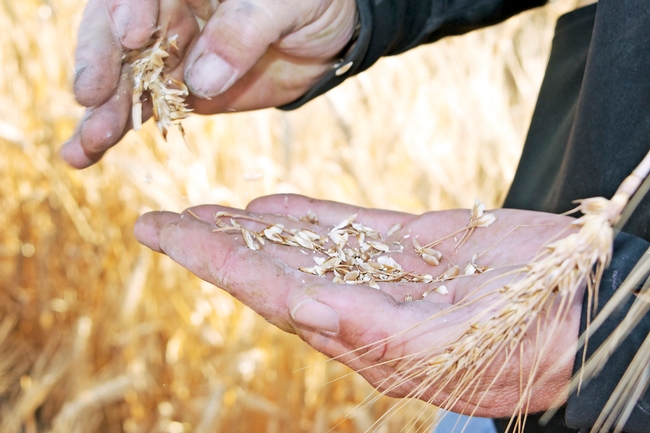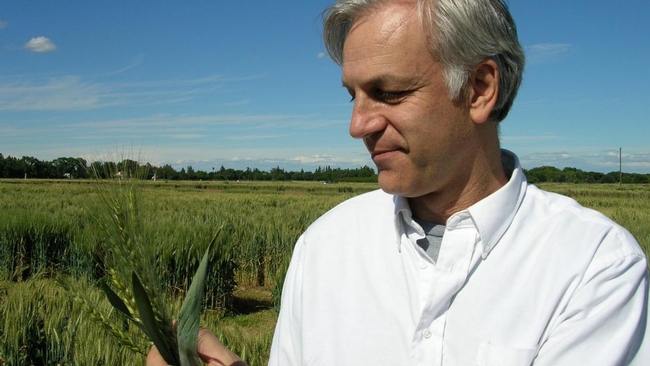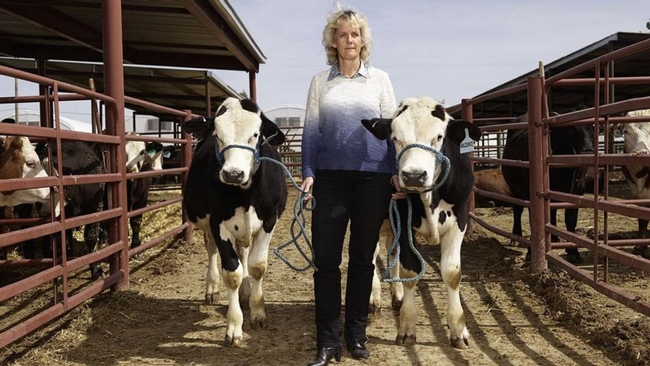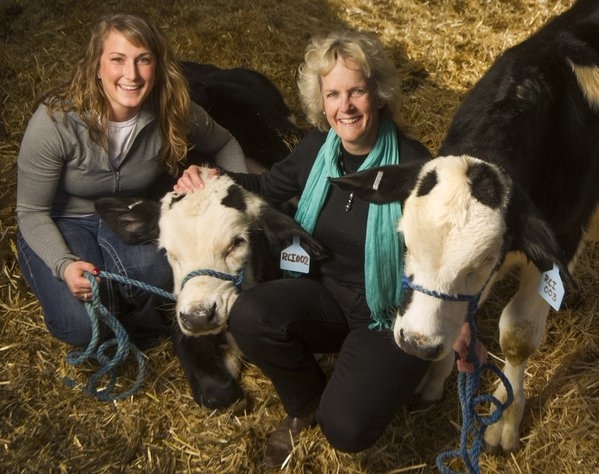Posts Tagged: gene
UC Davis team identifies wheat gene that increases yield
The findings could help growers produce more wheat without expanding operation
A team of scientists from University of California, Davis, have identified a new gene variant in wheat that can increase the amount of the grain produced, new research published in the journal PLOS Genetics finds.
Wheat is a staple of food diets worldwide and the gene discovery could allow farmers to grow more food without increasing land use. Increased yield could also lower consumer prices, making the crop more accessible.
“We have a growing human population that likes to eat every day,” said Jorge Dubcovsky, a plant sciences distinguished professor who led the research. “We need to produce more wheat in the same space so we need plants that are more productive.”
The researchers found a gene – WAPO1 – that controls the maximum number of grains in a wheat spike. Breeding the beneficial gene variant into the plants could delay the formation of the terminal spikelet, providing room for more grains to grow in each spike rather than ending production of grain.
WAPO1 is one of the first genes discovered that can affect wheat yield. “We are trying to make more productive wheat varieties and we are starting to understand how that trait is controlled,” Dubcovsky said.
Pasta wheat lacking the gene
The gene variant for high grain number is found frequently in bread wheats but not in pasta wheats. By breeding the beneficial gene variant into those pasta wheat varieties, growers could increase yield by 4% to 5% in cultivars that have the biomass capacity to fill the extra grains.
“We developed molecular markers to select for the form of that gene to produce increased yield,” Dubcovsky said. “It's a significant step forward.”
Previous research by the team mapped the gene and identified others that could affect yield. This research confirmed those findings for WAPO1.
Discovery on path to future yield increases
The WAPO1 gene is part of a network of genes that work together to control yield, and researchers need to identify the best variant combinations to maximize yield. Solving this puzzle can lead to better production rates.
“We will continue to try to understand the network of genes that control the yield of wheat,” he said.
Saarah Kuzay, Huiqiong Lin, Chengxia Li, Shisheng Chen, Daniel P. Woods and Junli Zhang from UC Davis also contributed to the research, as did scientists from Howard Hughes Medical Institute, Heinrich Heine University and Peking University Institute of Advanced Agricultural Sciences.
Funding was provided by USDAs National Institute of Food and Agriculture's Food Research Initiative, the International Wheat Yield Partnership and Howard Hughes Medical Institute.
UC ANR scientist looks to gene modification to improve animal agriculture
Scientists in labs across the world have used gene modification to create virus-resistant pigs, heat-tolerant cattle and fatter, more muscular lambs - potential improvements for animal agriculture - but will people ever eat them? asks reporter Carolyn Johnson in the Washington Post.
Johnson opened her story with a scene from UC Davis, where UC Cooperative Extension specialist Alison Van Eenennaam was conducting ultrasounds on cattle to determine whether they were pregnant. The animals had been implanted with embryos genetically edited to grow and look like males, regardless of their gender.
Also on the UC Davis campus, Van Eenennaam cares for five bulls and a heifer that represent the second generation of cattle whose genetic propensity to have horns has been edited out of their DNA. The process spares the animals the common de-horning procedure, which protects animals and animal handlers from gory accidents.
Gene-edited plants will soon be in grocery stores, but similar tinkering with the DNA of animals faces a far more uncertain future, the article said.
A setback to gene editing came in early 2017 when the FDA put out draft guidance indicating that animals with intentionally altered DNA would be regulated as containing veterinary drugs. And the complexity and difficulty of using gene editing was also noted in the story. The ultrasounds of cattle Van Eenennaam and her staff implanted with the genetically altered fetuses yielded no pregnancies.
November News Clips (11/1-11/14)
As wildfires grow deadlier, officials search for solutions
(Associated Press) Matthew Brown and Ellen Knickmeyer, Nov. 14
…"There are ... so many ways that can go wrong, in the warning, the modes of getting the message out, the confusion ... the traffic jams," said Max Moritz, a wildfire specialist with the University of California Cooperative Extension program.
As deadly urban wildfires become more common, officials should also consider establishing "local retreat zones, local safety zones" in communities where residents can ride out the deadly firestorms if escape seems impossible, Moritz said.
… In the mid-20th century, California ranchers burned hundreds of thousands of acres annually to manage their lands, said Lenya Quinn-Davidson, director of the Northern California Prescribed Fire Council.
That was phased out in the 1980s after California's fire management agency stepped in to take over the burns, and by the last decade, the amount of acreage being treated had dropped to less than 10,000 acres annually, Quinn-Davidson said.
Former agricultural land that rings many towns in the state became overgrown, even as housing developments pushed deeper into those rural areas. That was the situation in the Northern California town of Redding leading up to a fire that began in July and destroyed more than 1,000 homes. It was blamed for eight deaths.
"You get these growing cities pushing out - housing developments going right up into brush and wooded areas. One ignition on a bad day, and all that is threatened," Quinn-Davidson said. "These fires are tragic, and they're telling us this is urgent. We can't sit on our hands."
http://www.kulr8.com/story/39483128/fatal-california-fires-spur-search-for-solutions
Camp Fire vs. Tubbs Fire: The two most destructive fires in California history
(San Francisco Chronicle) Amy Graff, Nov. 14
Comparing California's most destructive wildfires -- the current Camp Fire and last year's Tubb's Fire -- College of Natural Resources Dean Emeritus Keith Gilless, also a forest economics professor, says: "One fundamental difference that occurs to me is that the Tubbs fire broke out late at night, which made notification and evacuation particularly difficult." Professor Gilless also discussed California's wildfires on WBUR's On Point program.
Trump and Brown stir up rhetoric on wildfires but overlook pressing problems
(LA Times) Bettina Boxall, Nov. 14
… “I've been following these issues for 40 years, and I don't remember a time when the issue of wildfire has ever been politicized anywhere close to the extent it is now,” said Richard Frank, director of the California Environmental Law and Policy Center at UC Davis.
… Similarly, UC Berkeley fire scientist Scott Stephens said that although climate change is playing a role in wildfire growth, he worries that a focus on global warming can leave the public thinking that “there's really nothing to be done.”
In fact, he said, “Communities could still be better prepared.”
http://www.latimes.com/local/lanow/la-me-fire-policy-trump-brown-20181114-story.html
Staggered evacuation plan questioned in fire's aftermath
(Associated Press) Paul Elias, Kathleen Ronayne, Nov. 14
…Paradise sits on a ridge between two higher hills, with only one main exit out of town. The best solution seemed to be to order evacuations in phases, so people didn't get trapped.
“Gridlock is always the biggest concern,” said William Stewart, a forestry professor at the University of California, Berkeley.
…Likewise, Stewart, the forestry professor, said the wildfire that hit Paradise disrupted the orderly evacuation plan because it “was moving too fast. All hell broke loose.”
He said experts continue to debate how best to issue evacuation orders and no ideal solution has been found.
Blueberry growers focus on open market window
(Ag Alert) Padma Nagappan, Nov. 14
…It makes sense to tap the market earlier in the year, when California growers are not competing with others entering the market and there are better margins to be had. That's why Ramiro Lobo and others from the University of California have been working on a long-term berry trial in Southern California, to look for the best varieties that can be produced early in the year.
"You have to be in the market as early as you can, because by April and beginning of May, the prices are so low, it doesn't even pay for the harvest," Lobo said. He is a small farms and agricultural economics advisor with UC Cooperative Extension.
http://www.agalert.com/story/Default.aspx?id=12300
Sanitation is foundation of Navel orangeworm control
(Farm Press) Logan Hawkes, Nov 14
So far this year, early estimates reveal that nut damage and subsequent losses from NOW larvae, will be less than in 2017, though the pest remains a major concern in almond, pistachio, and even walnut orchards. University of California Agriculture and Natural Resource (UC-ANR) advisors note that a successful management plan for controlling Navel orangeworm starts in the fall following harvest and continues through the winter months.
"Sanitation is the foundation of Navel orangeworm control," says Pheobe Gordon of UC Cooperative Extension. "Post-harvest sanitation is the first step in slowing the emergence of the pest when the new season begins."
… UC-ANR Extension IPM Specialist Dr. Jhalendra Rijal is one of the leading researchers on Navel orangeworm control in almonds and walnuts. "We have been working vigorously to better understand Navel orangeworms, how they reproduce, migrate, and survive,” he says.
https://www.westernfarmpress.com/tree-nuts/sanitation-foundation-navel-orangeworm-control
How Does California's Wildlife Cope With Massive Wildfires?
(Atlas Obscura) Anna Kusmer, Nov. 13
While many animals are indeed displaced by wildfires, it's important to note that fire is not wholly bad for landscapes in an ecological sense. In fact, many California ecosystems rely on fire to thrive. “Fire in the human sense can often be catastrophic, but it's not necessarily the same for animals,” says Greg Giusti, a retired University of California researcher and an expert on the relationship between wildfires and wildlife. He says California wildlife have evolved to respond to fires, and can even sometimes benefit from the disruption. “It's harsh out there, but you know these animals have evolved to survive in that hostile environment.”
There are a variety to survival tactics that California wildlife will use, says Giusti. For example, birds are easily able to fly away and are usually not impacted as long as fires don't occur during the spring when they are nesting and raising their offspring.
https://www.atlasobscura.com/articles/how-does-californias-wildlife-cope-with-massive-wildfires
The Manmade Causes Of California's Endless Fire Season
(OnPoint) Meghna Chakrabarti, Nov 13
California's endless fire season. Whether it's climate change, development or forest management, we'll look at the causes — all manmade.
Guests:
Scott McLean, deputy chief, chief of information for the California Department of Forestry and Fire Protection.
Ryan Lillis, reporter for the Sacramento Bee who has covered most of Northern California's fires for last 12 years. (@Ryan_Lillis)
J. Keith Gilless, professor of forest economics at University of California, Berkeley and chair of the California Board of Forestry and Fire Protection on Cal Fire's policy board.
Glen MacDonald, professor of geography at University of California, Los Angeles who has spent decades studying climate and the effects of wildfires. He and his family were among the hundreds of thousands of people who evacuated their homes because of the Woolsey Fire. (@GlenMMacDonald1)
http://www.wbur.org/onpoint/2018/11/13/californias-endless-fire-season-climate-change
California Must Better Prepare For The Inevitability Of Future Fires
(Pacific Standard) Max Moritz, Naomi Tague & Sarah Anderson, Nov 13
Wildfire has been an integral part of California ecosystems for centuries. Now, however, nearly a third of homes in California are in wildland urban interface areas where houses intermingling with wildlands and fire is a natural phenomenon. Just as Californians must live with earthquake risk, they must live with wildfires.
https://psmag.com/environment/california-must-better-prepare-for-future-fires
Forest management debate
(KTVU) Heather Holmes, Nov. 12
In a live interview, Bill Stewart, UC Cooperative Extension specialist at UC Berkeley, said,
“It was actually on the private land that we saw better performance in terms of being able to put out the fire quicker and a lot less smoke being produced. There is a package of vegetation management and fire suppression on private lands that have proved to be more effective than what's being used on federal land.
“What we found is about half the difference comes from the private land managers do more aggressive timber harvesting and some of that profit they spend to reduce the shrubs and fuels that are on the ground because they have that cashflow. They're protecting their long-term assets. The other half is CALFIRE is much more aggressive when it comes to fire suppression in forests or shrublands.
http://www.ktvu.com/news/372545595-video
Trump Right? Hack-and-Squirt the Forest. Created the Huge California Fire Hazard
(Mary Greeley News) Mary Greeley, Nov. 12
On average, the cost of thinning forests through hack-and-squirt while leaving the dead trees standing is about $250 per acre, said Greg Giusti, a forest advisor with the University of California Cooperative Extension. The cost of cutting and leaving them on the ground is about $750 an acre, while cutting and hauling them away is about $1,000 an acre.
https://www.youtube.com/watch?v=tEOETb7ttaY
Trump's Misleading Claims About California's Fire ‘Mismanagement'
(New York Times) Kendra Pierre-Louis, Nov. 12
…Mr. Trump is suggesting that forest management played a role, but California's current wildfires aren't forest fires.
“These fires aren't even in forests,” said Max Moritz, a wildfire specialist at the University of California, Santa Barbara.
…“We have vulnerable housing stock already out there on the landscape. These are structures that were often built to building codes from earlier decades and they're not as fire resistant as they could be,” Dr. Moritz said. “This issue of where and how we built our homes has left us very exposed to home losses and fatalities like these.”
https://www.nytimes.com/2018/11/12/us/politics/fact-check-trump-california-fire-tweet.html
Carbon Farming Initiative Takes Tentative First Steps in Santa Ynez Valley
(Noozhaw) Garrett Hazelwood, Nov. 12
On a recent morning in the Santa Ynez Valley, a crowd of people gathered at the Ted Chamberlin Ranch to discuss soil health and so-called carbon farming.
The event –– hosted by the Community Environmental Council, the Cachuma Resource Conservation District, and the Santa Barbara Agricultural Commissioner's Office –– showcased successful carbon farming trials recently conducted on the ranch, and was attended by local landowners, environmental activists, scientists and county officials.
Matthew Shapero, Livestock and Range Advisor for the UC Cooperative Extension, explained that the grasses surrounding the site had sprouted green last spring and have since died in the heat of summer, becoming what he calls “residual dry matter.” Now the brittle, golden shoots have become a sparse cover for hard-packed soil that's cracked and dry.
California's year-round wildfire threat: Why aren't communities doing more?
(SF Chronicle) Peter Fimrite and Kurtis Alexander Nov. 10,
…“To have a president come out and say it's all because of forest management is ridiculous. It completely ignores the dynamic of what's going on around us.” said LeRoy Westerling, a climate and fire scientist at UC Merced, who blamed the increasing number of fires on rising temperatures and more variable precipitation, leading to longer spells of dry weather.
…“It's like a tragic replay of last year, with strong winds in both Northern California and Southern California blowing fire,” said Max Moritz, a wildfire specialist at the Bren School at UC Santa Barbara, recalling the 2017 Wine Country fires and the Thomas Fire, which burned through Ventura and Santa Barbara counties in December.
…“We had a lot of discussion after the fires last year about the liability issue with utilities, but it's interesting to see what didn't happen,” Moritz said. “Nobody has talked about mapping neighborhoods and homes in fire-prone areas like they do in flood plain hazard zones, engineering resilience into communities, or building a little smarter.”
…Everybody agrees the situation is dire. Fire officials blame shorter winters, hotter temperatures and drier vegetation, but very little is being done to improve the situation, said Scott Stevens, a professor of fire science at UC Berkeley.
“There is an under-appreciation of fire risk in a lot of communities,” Stevens said. “It feels like we can do better at allowing local communities to access information, reduce their vulnerability and understand their vulnerability a little bit more.”
Stevens urged the creation of cooperative programs at his and other universities that would allow local government officials to collaborate with fire experts on safety planning.
California's most destructive wildfire should not have come as a surprise
(LA Times) Bettina Boxall and Paige St. John, Nov. 10
…“We have these Santa Ana-like events happening in places that are appearing to catch people by surprise,” said Max Moritz, a cooperative extension wildfire specialist at UC Santa Barbara's Bren School. “But they shouldn't be catching people by surprise.”
“These are areas that have burned before,” he said. “And if we were to go back and do the wind mapping, we would find that at some intervals, these areas are prone to these north and northeasterly Santa Ana-like events.”
… “We have all kinds of tools to help us do this smarter, to build in a more sustainable way and to co-exist with fire,” he said. “But everybody throws up their hands and says, ‘Oh, all land-use planning is local. You can't tell people that they can't build there.' And the conversation stops right there.”
http://www.latimes.com/local/lanow/la-me-camp-fire-science-20181110-story.html
Are Organic Farms Ruining California's Rural Coast?
(Pacific Standard) Laura Fraser, Nov. 9
David Lewis, county director of the UC Cooperative Extension in Marin County, estimates that the Point Reyes ranches contribute as much as 20 percent of the county's $110 million in annual agricultural production. Given the industries that support agriculture—feed companies, veterinary services, a grass-fed beef butchery—the overall economic output of the ranches may be three times that amount. If the ranches closed, Lewis says, "You'd be losing about $60 million a year in production." The ranchers also contribute more than 5,000 jobs in the region, on and off the farms.
https://psmag.com/.amp/environment/are-organic-farms-ruining-california-rural-coast
Countries Embrace Genome Editing in Contrast of EU's Opinion
(AgNet West) Brian German, Nov. 8
The United States joined 12 other nations to encourage policies to enable continued agricultural innovation, including genome editing. Australia, Canada, Brazil, and Vietnam were among the countries issuing support of the International Statement on Agricultural Applications of Precision Biotechnology. Noticeably absent from the joint statement of support was the European Union (EU).
…“Ideally, or in theory, regulations are meant to be in place to address risk. And so the more risk, the more regulation and the less risk the less regulation,” said Alison Van Eenennaam, Animal Genomics and Biotechnology Specialist at UC Davis. “But in this case, it's just regulation triggered by a particular process irrespective of the risk of the product.”
http://agnetwest.com/countries-genome-editing-contrast-eu/
University of California's Glenda Humiston wins 2018 California Steward Leader Award
(CA Economy) Nadine Ono, Nov. 8
Glenda Humiston has always been involved in rural issues from her days growing up on a farm to her current position as vice president of University of California Division of Agriculture and Natural Resources.
“I was really involved in the 1990s in trying to figure out how agriculture and environmental interests find common ground, as well as building bridges between rural and urban sectors," said Humiston. "In the 2000s, I started focusing on economic development and sustainability. In my current job, I'm bringing all of those together around the reality that sustainability truly has to be a triple bottom line. We've got to develop ways for people, the planet and prosperity to all thrive and enhance the synergies between them."
Humiston will be awarded the 2018 California Steward Leader Award at the California Economic Summit. She currently serves on the 2018 Economic Summit Steering Committee, as well the Action Team co-lead for Working Landscapes and co-chair of the Elevate Rural California initiative.
Instances of Bindweed Popping Up in Central Valley Farms
(AgNet West) Brian German, Nov. 7
Waterhemp is continuing to cause some concern in and around Merced County, but there is another problematic weed species that growers should be aware of and remain on the lookout for. “Bindweed is actually a big problem throughout the central valley of California,” said Agronomy and Weed Science Advisor for Merced and Madera Counties, Lynn Sosnoskie. “It's really a concern particularly where we have crops that are grown on drip irrigation and reduced tillage systems.”
http://agnetwest.com/bindweed-popping-central-valley-farms/
Agriculture group to hear from extension speaker
(Ventura County Star) Nov. 7
The Ventura County chapter of California Women for Agriculture will host a presentation by Annemiek Schilder of the University of California Cooperative Extension and Hansen Agricultural Research and Extension Center.
Minorities Are Most Vulnerable When Wildfires Strike in U.S., Study Finds
(New York Times) Kendra Pierre-Louis, Nov. 3
…The study, which appears in the journal PLoS One this month, suggests that people of color, especially Native Americans, face more risk from wildfires than whites. It is another example of how the kinds of disasters exacerbated by climate change often hit minorities and the poor the hardest.
…Rachel Morello-Frosch, a professor of environmental health at the University of California, Berkeley, said the research could be useful in preparing for future disasters. “Results of this study can help inform planning and outreach efforts to enhance the resilience of fire-prone communities, particularly for communities of color that are often overlooked when these disasters happen,” she said in an email.
https://www.nytimes.com/2018/11/03/climate/wildfires-minorities-risk.html
Wildfire Risk A Key Issue In California Insurance Commissioner Race
(Capital Radio) Ezra David Romero, Nov. 2
…"I recently talked to a homeowner who had his insurance canceled about three months before his house was destroyed by a wildfire,” said UC Cooperative Extension forestry and natural resources advisor Susan Kocher.
Kocher says calls from homeowners come often, and that people's reality is something the new commissioner will have to deal with: a complicated insurance system and a warming climate that's increasing the number, size and impact of fires in California.
A New Hue
(California Bountiful) Kevin Hecteman, Nov. 1
… C. Scott Stoddard, a University of California Cooperative Extension farm advisor in Merced County, is running trials with different purple varieties, working in concert with a sweet potato breeder at Louisiana State University.
One recent test variety, he noted, started off well from a color and yield standpoint a couple of years ago, but the interior color wasn't quite purple enough—he was getting more of a lavender potato.
"We are still very experimental," Stoddard said. "There's nothing that looks like it's going to have something there any time soon."
http://www.californiabountiful.com/features/article.aspx?arID=2204
Eating right learned at school
(Roseville Press Tribune) Carol Feineman, Nov. 1
More than 25 percent of youth ages 5 to 19 are overweight in Placer and Nevada counties, according to University of California CalFresh Nutrition Education Program, Placer/Nevada counties. The program is part of the University of California Cooperative Extension.
UC CalFresh is trying to lower that percentage by offering nutrition classes for adults and also teaching some Roseville, Lincoln and Sheridan public school students how to eat healthier. The organization also works with area school gardens.
…“As students get older, they're making more of the choices themselves. So many kids end up being home by themselves or packing their lunch,” said Rosemary Carter, UC CalFresh program manager for Placer-Nevada Counties. “I want them to understand what the healthy foods will do for their bodies. I want them to make the healthy choices, to make an educated choice.”
http://www.thepresstribune.com/article/11/01/18/eating-right-learned-school
Why the FDA's plan to regulate gene editing in animals has some scientists worried
(Pacific Standard) Emily Moon, Nov 1
…While genetically engineered animals have been met with controversy, animal geneticist Alison Van Eenennaam believed her own work would be immune. In her lab at the University of California–Davis, Van Eenennaam uses genetic editing technology to develop cows without horns. The process, she says, is no different than traditional breeding, in which breeders select for naturally occurring mutations. "Nature does this routinely, because there are always breaks getting introduced into double-stranded DNA by radiation and sunlight and alcohol, you name it," she says. "That's how evolution happens."
Five UC Cooperative Extension advisors retired on July 1, 2018
At the end of June, the distinguished careers of five UC Cooperative Extension advisors concluded when they retired. The new retirees are
- Mark Gaskell, UCCE small farms advisor for San Luis Obispo and Santa Barbara counties
- Gene Miyao, UCCE vegetable crops advisor for Yolo, Solano and Sacramento counties
- Kim Rodrigues, director of the Hopland Research & Extension Center and UCCE forest advisor
- Blake Sanden, UCCE irrigation, soils and agronomy advisor in Kern County
- Steve Tjosvold, UCCE horticulture advisor for Santa Cruz and Monterey counties
Below are brief vignettes about each of the retirees.
UCCE small farms advisor Mark Gaskell retires
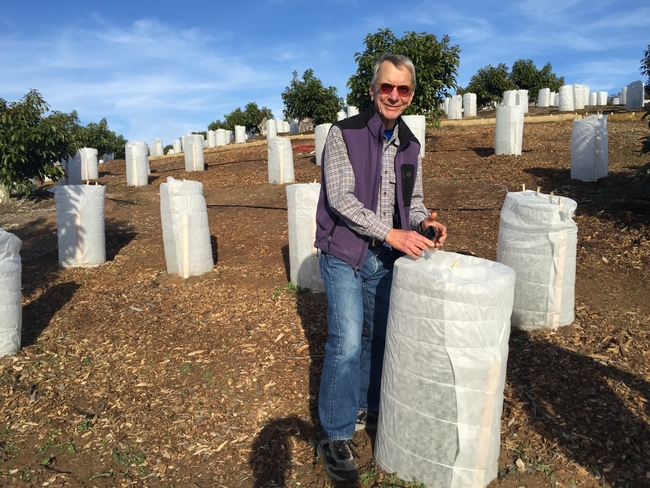
Gaskell, who began his career with the University of California's Division of Agriculture and Natural Resources as an advisor for small farms and specialty crops in San Luis Obispo and Santa Barbara counties in 1995, retired July 1.
“If it wasn't for Mark Gaskell, I wouldn't have lasted three years,” said Tony Chavez, who grows 40 acres of blueberries, blackberries and some raspberries in Nipomo.
Blueberries weren't grown in California until Gaskell planted test plots of southern highbush blueberries in 1996 to give small-scale growers a new crop option. What was once a niche crop is now planted on over 7,000 acres in the state and California currently leads U.S. production of fresh blueberries.
Recently Gaskell's knowledge of coffee production has been in demand.
“Personally, I would not be where I am today professionally without Mark's guidance, support and friendship,” said Jay Ruskey, CEO and co-founder of Good Land Organics. “He brought me my first coffee plants in 2002.”
With Gaskell's research-based advice, the Goleta grower has produced premium coffee. His Caturra coffee made Coffee Review's Top 30 coffees in 2014 and in 2017 Daily Coffee News reported that Blue Bottle was selling the California-grown coffee for $18 per ounce.
“Industry-wide, there are many farmers who have benefited directly from working with Mark, but there are far more farmers who are currently benefiting today from the specific crops and farming systems he has introduced through his service as a University of California farm advisor,” Ruskey said. (Author: Pam Kan-Rice)
Gene Miyao, UC Cooperative Extension vegetable crops advisor, retiring after 38 years
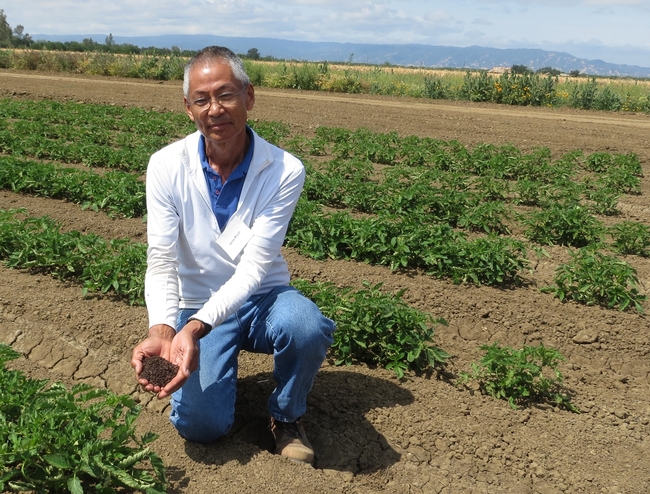
Miyao had been exposed to UCCE farm advisors from a young age.
“My parents were small-scale farmers in Yolo County. We knew of the value of UCCE and the UC system,” Miyao said.
During his 38-year-career, Miyao has witnessed dramatic changes in production systems of processing tomatoes, a crop on which he focused much of his efforts. Growers went from using open-pollinated seed to hybrids and they changed from direct seeding to transplants. Tomato production has seen a major reduction in Phytophthora root rot, and a rapid spread of Fusarium wilt race 2.
Over the years, Miyao has conducted significant research, including work to better understand the benefits of cover crops, supplemental applications of potassium and phosphorous, and applying composted chicken manure in tomato production. He cooperated with a team of advisors to demonstrate the value of sulfur dust for powdery mildew control and the risk of spreading the disease fusarium wilt from infested stem pieces. Miyao was an author of the recent cost production study titled Cost of producing processing tomatoes in the Sacramento Valley and Northern Delta with sub-surface and surface drip irrigation.
In all Miyao wrote 69 peer reviewed articles. However, he said, the local newsletters, field meetings and field calls were always his priority in order to stay well connected to his local clientele.
In retirement, Miyao said he will complete some of his 2018 field projects. He's also planning to travel with his wife Donna to national parks and other destinations. And he is looking forward to fishing in the local waters. (Author: Jeannette Warnert)
Kim Rodrigues, Hopland Research and Extension Center Director, retires after 27-year career with UC ANR
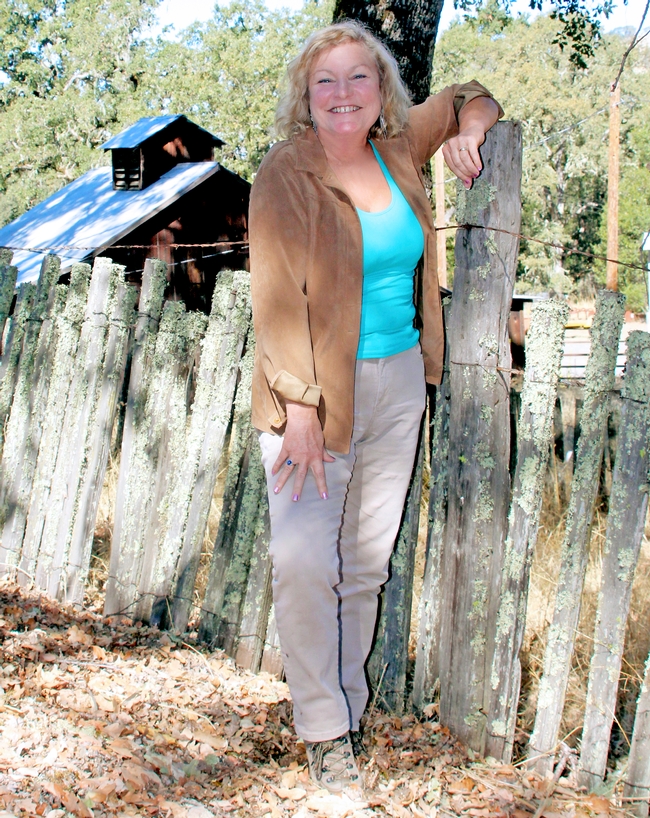
When she became regional director for the 23 counties in the North Coast and Mountain Region in 1999 and relocated her family to Davis from Eureka, she recounted that “it was July, and they went from cool, coastal fog to the Valley heat and wondered about my sanity!”
She later became the executive director of Academic Personnel for ANR when the regions were restructured and ANR was centralized.
She returned to county-based academic work at HREC in the summer of 2014. Initially there as an interim assignment, Rodrigues fell in love with the place and the people and accepted the formal assignment at HREC in 2015. She notes that working at HREC has been “an excellent culmination to my career. Working with colleagues on relevant research, such as living with wildlife, integrates the many professional roles I have had throughout my career.”
Noted as a competent and trusted forester, she has served on the State Board of Forestry and Fire Protection (BOF) briefly and on the BOF Professional Forester's Examining Committee for several years.
Rodrigues is also known for her collaborative leadership and facilitation skills and led the public participation team, together with Drs. Maggi Kelly and Lynn Huntsinger, for the long-term research titled the Sierra Nevada Adaptive Management Project. She is recognized as an excellent facilitator for large-scale and smaller scale public meetings designed to share science with diverse public interest groups, agencies and decision-makers, in order to seek new solutions for resolving ongoing conflicts over public trust resources, such as water, wildlife and more.
Her passion is working with diverse groups to address complex environmental conflicts to seek shared understanding and new agreements. “It is amazing how diverse input can help frame innovative solutions that individuals or small groups may not readily identify,” she said.
She plans to remain engaged in research and extension related to living with wildlife, cumulative watershed effects and managing conflicts of all types. She is also looking forward to spending more time with her husband, four children and grandchild.
Although sad to leave many aspects of her work at UC ANR, she said, “I remain deeply grateful to UC ANR for such a wonderful career, and I remain committed to support UC ANR to succeed in any way I can going forward. I have been fortunate to work with amazing colleagues and truly respect the work we do for the land grant mission.” (Author: Liz Sizensky)
Blake Sanden, UCCE irrigation, soils and agronomy advisor in Kern County
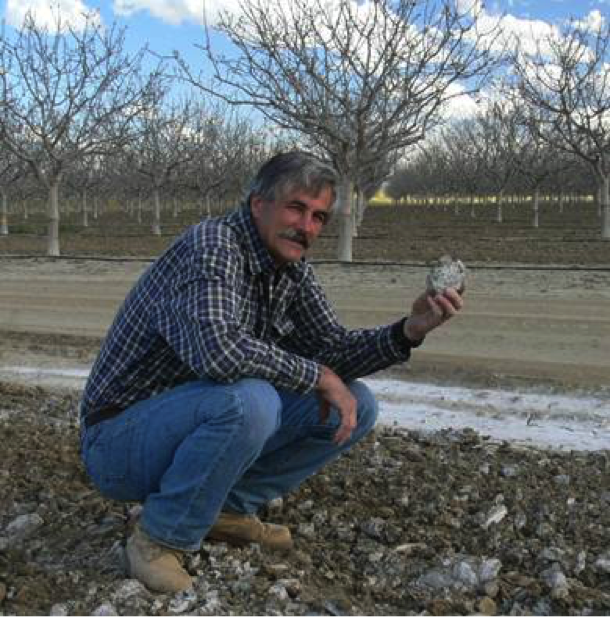
He helped growers with on-farm soil and water problems, organized and spoke at workshops across California and conducted applied field research projects focusing on irrigation, salinity/fertility management for all crops, and agronomic field crop production of alfalfa, dry beans and oil crops.
Blake has a bachelor's degree in International agricultural development and agronomy and master's degree in irrigation and drainage from UC Davis and 35 years of experience in California production ag, international ag development and extension.
Significant projects of his include: development of salt tolerance thresholds for high production California pistachios in the San Joaquin Valley, soil moisture monitoring techniques and irrigation efficiency assessment on 12,000 acres in Kern County and deficit irrigation in early citrus navel oranges.
Over the last eight years, Sanden has fulfilled a vision that started nearly 30 years ago. Through collaboration with nearly 50 University of California researchers, farm advisors, extension specialists, the Wonderful Farming Company and almond industry representatives, he played a crucial role in documenting the increased level of water and fertilizer use necessary for optimal almond yield – increasing the statewide average yield by more than 50 percent.
But some of his greatest joys and heart-felt satisfaction lay in development work in Africa – 3 years of missionary service in the 1980s developing vegetable gardens in Zambia and month-long training/consulting trips working with farmers and extension agents in Uganda, Ethiopia and central Asia.
When asked what he'll miss the most about his career, he said the interaction with the growers, most notably “seeing the ‘ah-ha' light up in a grower's eyes when he finally grasps the solution.”
He remembered a particular time in May of 2004 when a sugarbeet grower called him seeking his advice on whether or not to irrigate his 380 acres of beets one last time before harvesting. That was the way he had always done it. So Sanden went out and spent a couple of hours using his hand probe to check the moisture of the fields down to a three-foot depth.
“I ask, ‘Ken, when did you last probe this field?'” Sanden recalled.
‘“Oh, I really didn't check it this year?' he says.”
“Do you really need to irrigate or is this enough water to get through harvest?” noting that he already had enough moisture.
“I guess it's enough, but that's why I asked you out here. It wouldn't hurt to put on the irrigation would it? I'd feel better. Of course we did get the digger stuck a couple times last year because the field was too wet.”
“Too much water does hurt beets because you will reduce sugar percentage and can get rot and lose tonnage,” Sanden replied.
“OK, it makes me a bit nervous but you say I have at least four inches of water stored in the soil that the beets can get at.”
That year Ken was the top sugar producer in Kern County and got the Silver Beet Knife for highest percentage of sugar, Blake recalled.
“With that two hours worth of field scouting he probably made an extra $300,000 in the saved irrigation and increased sugar,” Blake said. (Author: Tyler Ash)
Steve Tjosvold, UC Cooperative Extension environmental horticulture advisor, 38 years
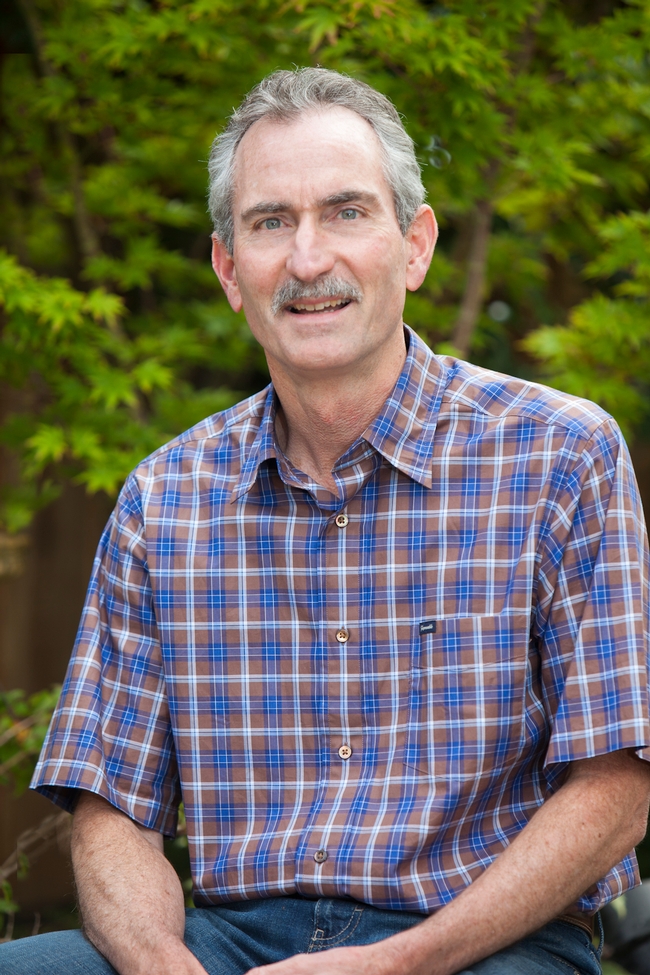
“I interned for two advisors and then separately filled in for the programs of two advisors that went on sabbatical leave,” Tjosvold said. “I use that experience, knowledge, contacts and friendships to this day.”
Tjosvold was named the environmental horticulture advisor in Santa Cruz and Monterey counties in 1983.
Tjosvold's early career focused on the management of nursery and landscape plant diseases and insect problems, as well as methods to improve water use and postharvest handling in nursery crops. In addition, Tjosvold helped establish the use of scouting in ornamental production by working with other farm advisors to document effectiveness statewide. Later, his research and outreach on sudden oak death and light brown apple moth helped growers understand the pests and take action to reduce their impact on production systems and the environment.
Tjosvold wrote or contributed to 94 peer-reviewed publications and 234 industry publications. He served as editor/co-editor of UCNFA (UC Nursery and Floriculture Alliance) News.
During his career, Tjosvold received three distinguished service awards for outstanding teamwork (1997, 2004, and 2006) and one for outstanding extension (2004). He received the 2008 Western Extension Directors' Award of Excellence for a farm water quality planning project. In 2012 he received the outstanding research award from the California Association of Nurseries and Garden Centers, and in 2015 he was honored with the Award of Excellence from the Western Extension Directors Association for a team effort that addresses Sudden Oak Death.
In retirement, Tjosvold plans to start a UCNFA blog to help replace the loss of the UCNFA newsletter due to retirements. He will also be available locally for focused educational projects and consultation. Tjosvold, an avid fly fisherman, said he will spend the first month of his retirement camping and fly fishing in Montana. (Author: Jeannette Warnert)

UC Cooperative Extension advisors retiring in 2018.
UCCE genetics specialist Alison Van Eenennaam a 'rising star'
UC Cooperative Extension specialist Alison Van Eenennaam, an animal geneticist based at UC Davis, was named a 'rising star' in the online magazine ozy.com.
Van Eenennaam operates at the forefront of biotechnology in animal agriculture, wrote reporter Marissa Fessenden. The researcher is raising cows in Davis whose genes were edited to omit horns, which spares the animals the painful process of horn removal.
The article says Van Eenennaam grew up as a 'horse-mad' city girl in Melbourne, Australia. She studied animal science at the University of Melbourne, and later earned master's and doctorate degrees at UC Davis. Van Eenennaam is an outspoken advocate for new technologies and works to separate misinformation from fact.
"We have to speak up," she said. "We're the people who know how (genetic editing) could be useful and how incredibly valuable the tool is. I'm not going to let the fearmongers dominate the conversation."
